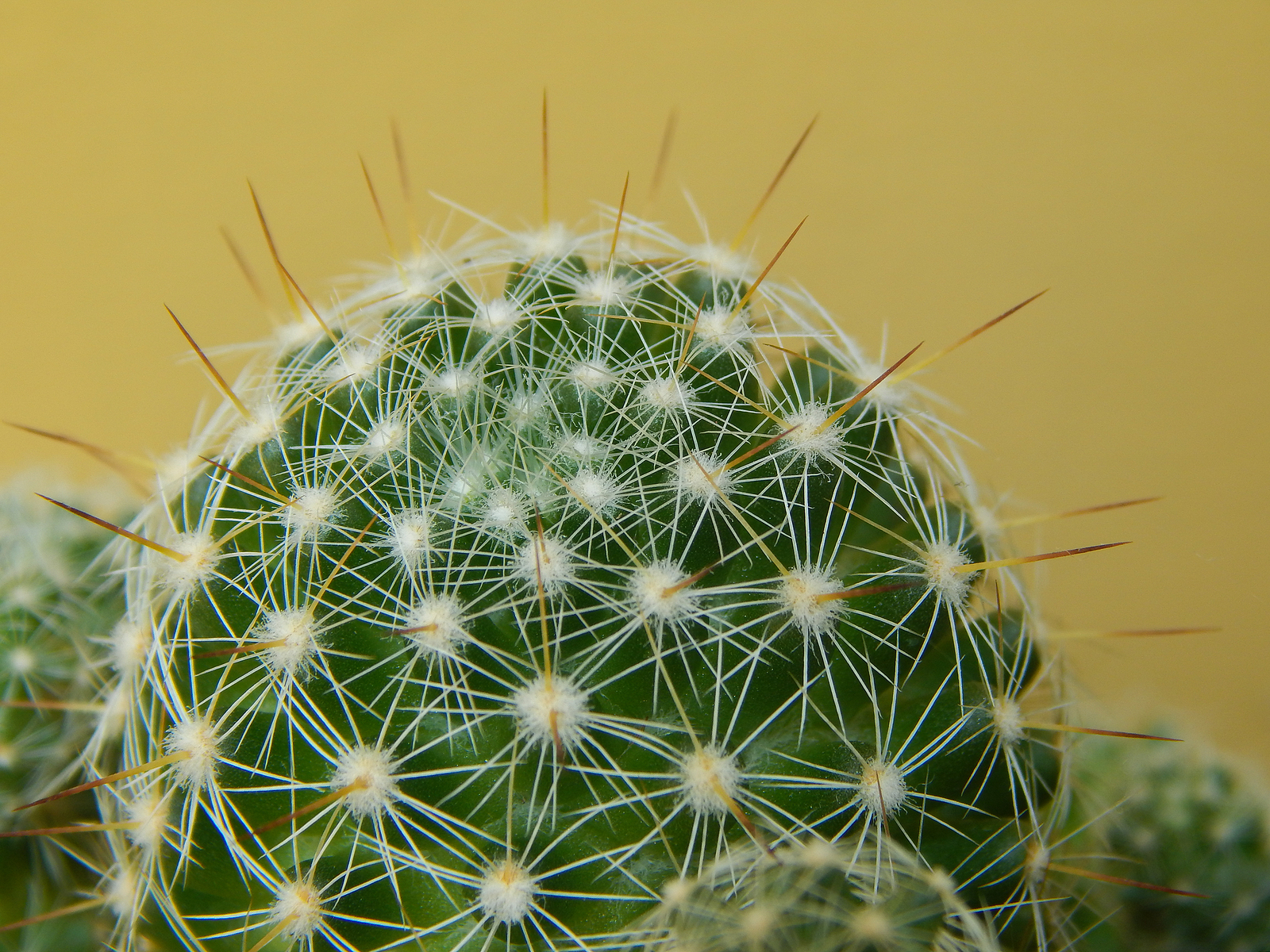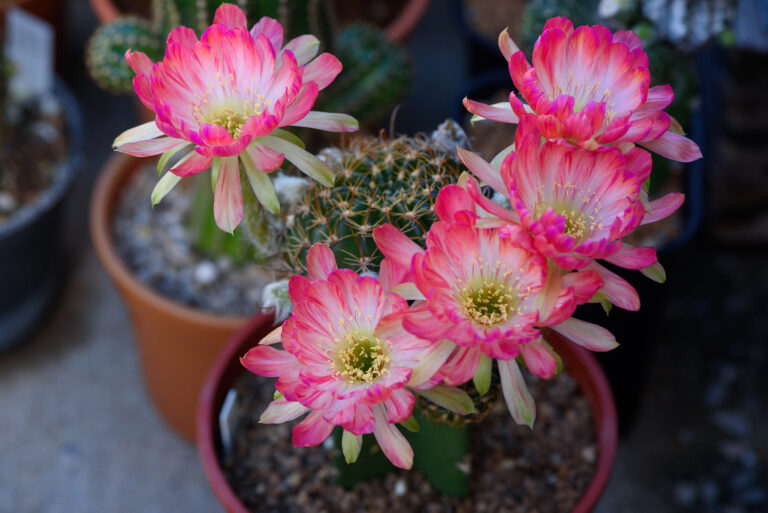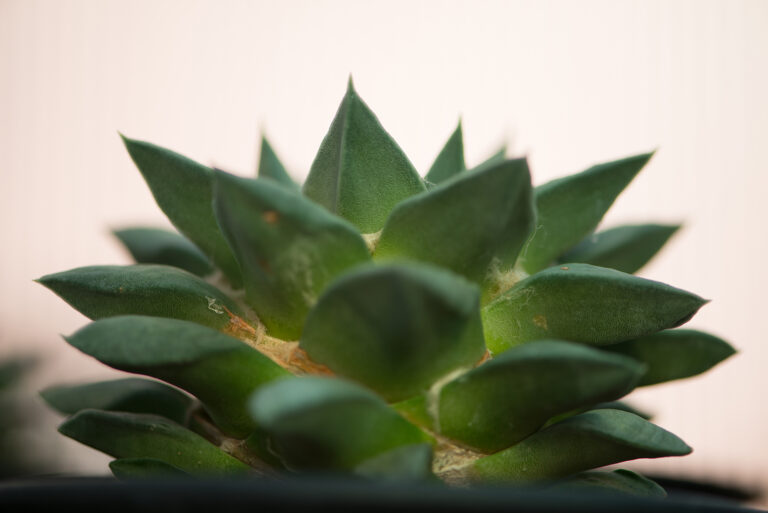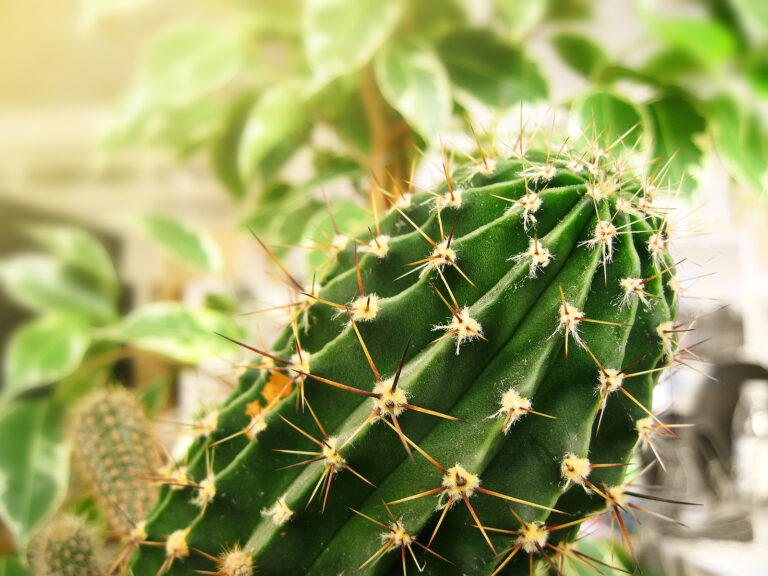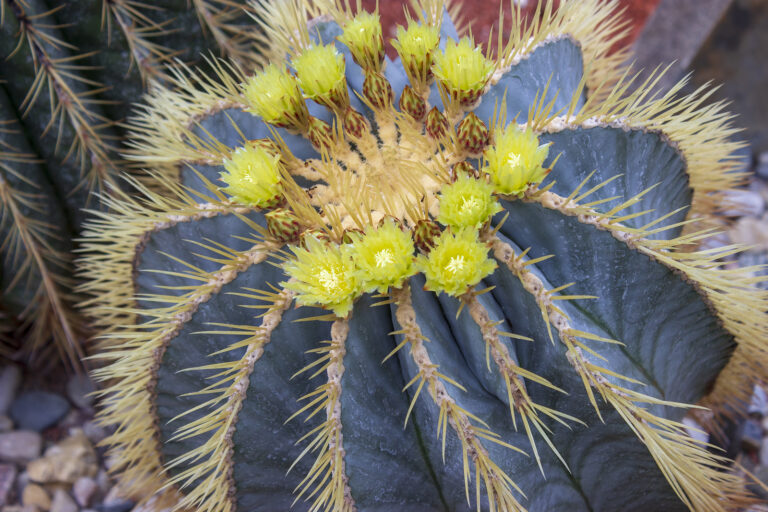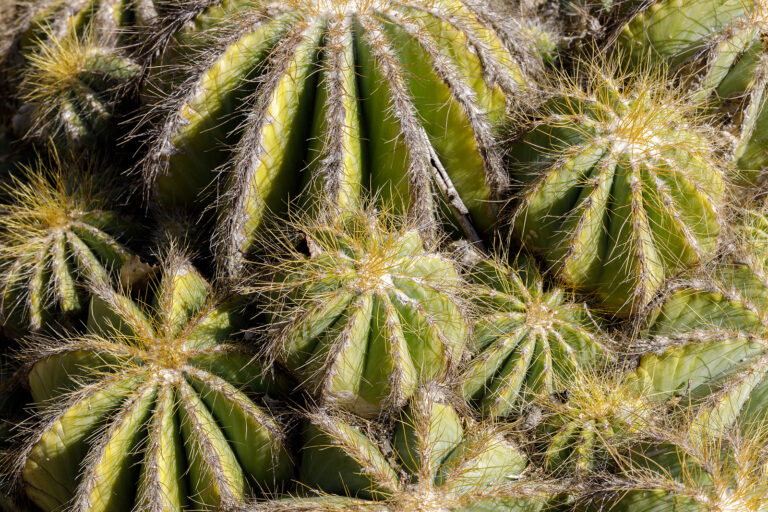How to Grow Mammillaria – Pincushion Cactus
Mammillaria–commonly called pincushion cactus–is a very large genus of cacti. There are many shapes, sizes, and colors. Some are solitary plants, some are clustering groups. Some have soft bristles, some have thorny hooks. Some are crowned with a few single flowers, some are adorned with a circle of flowers.
Most Mammillaria are small, globular, or cylindrical and less than 12 inches tall (30cm). There are more than 350 species of Mammillaria. Mammillaria includes low-growing clusters or single-stemmed plants, with an assortment of spines. All have tubercles (mamilla) that are arranged in an orderly spiral. The tubercle spirals replace ribs.
Mammillaria flowers grow out of the axils between tubercles. Flowers grow like wreaths around the body of the plant. The axils are covered with woolly hairs or bristles. The areoles are often covered with wool or felt.
Mammillaria spines are straight, bent, or hooked. They can be long or short and fine or coarse.
Mammillaria flowers can be large or small and are white, yellow, or red.
Mammillaria are easy to grow. They are well suited for indoors in bright light, windowsills, greenhouses, and lath houses.
Common names of popular Mammillaria cactus
The Mammillaria genus, known for its small, globe-like cacti, is one of the largest genera in the cactus family. Here are some popular species:
- Mammillaria elongata (Ladyfinger Cactus): This species is known for its long, finger-like stems covered in golden spines, often forming dense clusters, making it a favorite in cactus collections.
- Mammillaria hahniana (Old Lady Cactus): Covered in soft, white spines and tiny pink or purple flowers, this spherical cactus looks woolly, giving it the nickname “Old Lady Cactus.”
- Mammillaria gracilis (Thimble Cactus): A small, clumping species with delicate, white spines, this cactus forms dense mats and is popular for its ease of propagation.
- Mammillaria spinosissima (Red-Headed Irishman): This species features dense, reddish-brown spines and produces bright pink to purple flowers that bloom in a ring around the top of the cactus.
- Mammillaria bocasana (Powder Puff Cactus): Recognized by its soft, white, hair-like spines and small clusters of pink flowers, it looks like a soft, puffed-up plant but still has sharp spines hidden underneath.
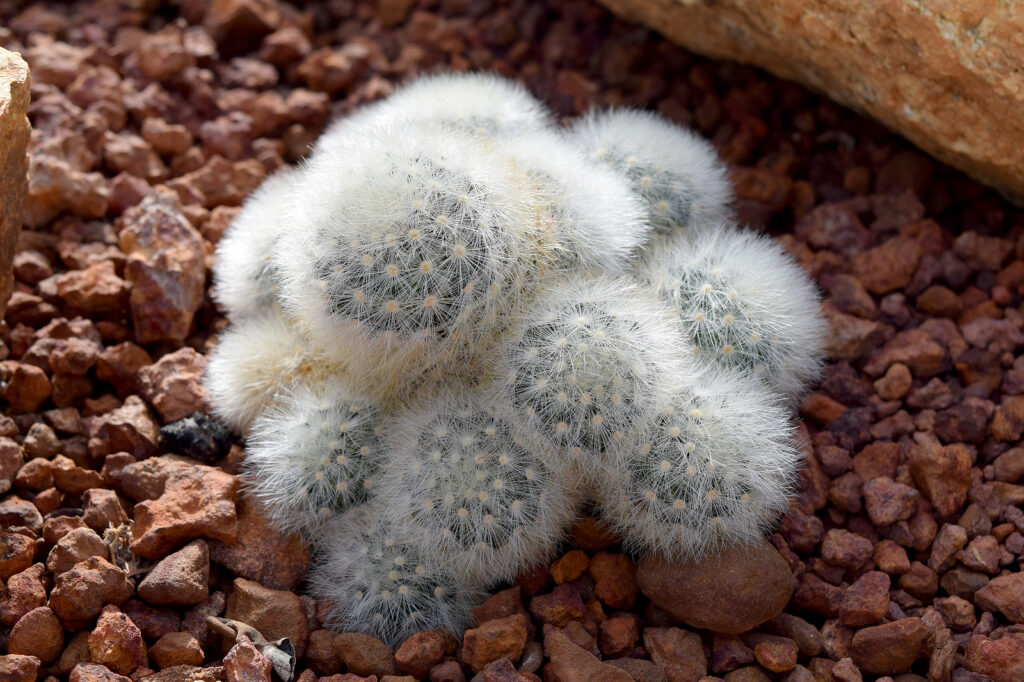
Get to know Mammillaria
- Plant type: Cactus, pincushion cactus
- Hardiness temperature: 35℉ (1.7℃)
- Optimal growing temperature: day, 70° to 85°F (21° to 29°C); night, 60°F (16°C).
- Shape and size: A variety of shapes, sizes, and colors; some grow to 12 inches tall (30cm), others are shorters; spined with soft bristles or thorny hooks, and crowned with a few single flowers or a circle of small blooms.
- Flowers: Flowers are small and often borne in rings around the crowns of the plants; flowers are white, yellow, or red.
- Bloom time: Spirng and summer
- Common name: Pincushion cactus
- Genus name: Mammillaria
- Family name: Cactaceae
- Origin: Mexico
Planting Mammillaria
- Grow Mammillaria in full sun or partial shade.
- Mammillaria to trigger flowering.
- Grow Mammillaria in average or slightly sandy soil.
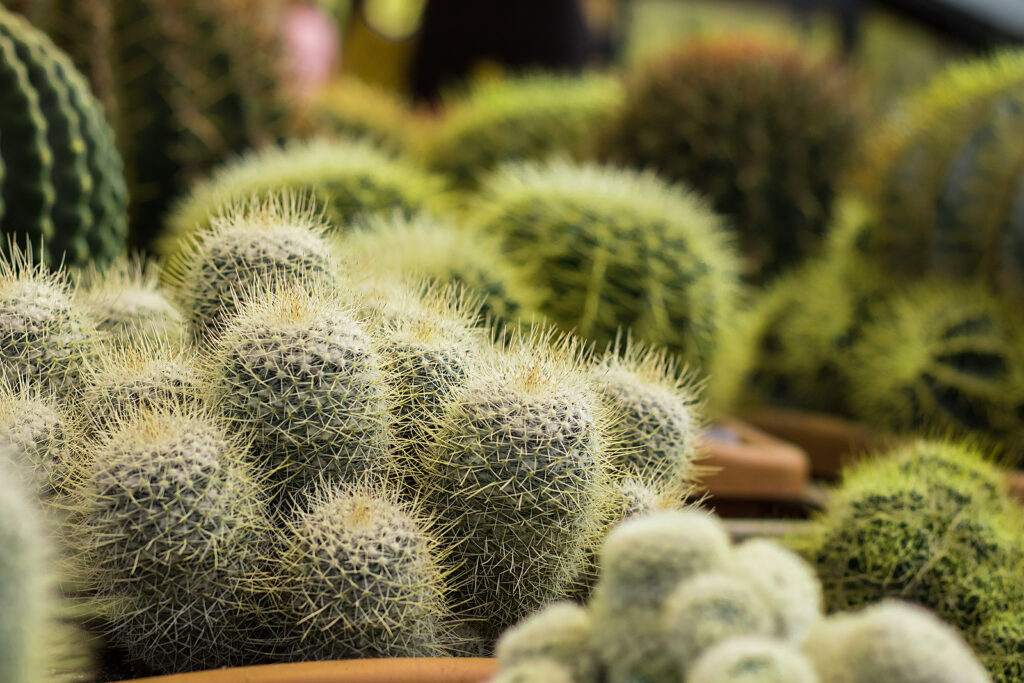
How to water and feed Mammillaria
- Mammillaria needs infrequent but ample amounts of water.
- Let soil dry between thorough waterings. Avoid overwatering. Humidity, 30% to 45%.
- Feed Mammillaria once a year, in spring, with high-phosphorus fertilizer.
Mammillaria care
- Repot Mammillaria when pot space is overcrowded.
- Mammillaria are commonly propagted from offsets; some are grown from seed.
- Keep Mammilaria light and dry, rather than cool during the winter. Set plants in a cool place, 65°F (18°C), with 5 hours of sun daily. Water just enough to keep foliage from shriveling.
- Water Mammilaria sparsely during the winter dormancy period.
Growing Mammillaria as a houseplant
- Mammillaria bocasana, M. elongata, and M. wildii are good choices for growing indoors.
- Give Mammillaria direct light, an average to warm temperature, and low humidity.
- Water infrequently and allow the soil to dry between waterings.
- Apply a liquid all-purpose fertilizer once a year in spring.
Mammillaria pests and diseases
- Check for aphids, mealybugs, spider mites, scale. Also, be alert for fungus.
Mammillaria propagation
- Propagate Mammillaria by offsets or seeds.

Mammillaria species to grow
- Mammillaria bocasana (powder puff). Globular shape; clustering cushionlike habit; hooked central spine is yellow, points downward and out; snow white silky hair and yellow flowers. Easily raised from seed.
- M. bombycina (silk pincushion). Globular to cylindrical shape with age; silky white spines contrast with darker central ones; bears red flowers in garlandlike circle at crown.
- M. bocasana, powder puff cactus. Grows to 1 ½ inches (4 cm) tall; 2-inch (5 cm) blue-green stems form a cluster, covered by soft white hairs interspersed with curving yellow spines; flowers are yellow.
- M. candida (snowball pincushion). Flattened, spherical body densely covered with short white spines that have brown tips.are white; purple red flowers appear in spring.
- M. celsiana. Single stem, branching into clusters as it matures; grows up to 5 inches (13 cm) tall; blue-green leaves bear regular pattern of white and pale yellow spines; flowers are red.
- M. compressa. Clumping species can grow to 3 feet wide; gray green body covered with short, milky tubercles; needle-shaped spines are white; one is curved downward; bears purple red flowers in spring.
- M. comptotricha (bird’s nest cactus). Plant clusters has a tangled, messy appearance; nearly inconspicuous tiny white flowers have a sweet, lime scent.
- M. confusa. Globular to clustering plant spiral configuration of tubercles; wooly white bristles contrast with dark radial spines; flowers are greenish white and appear in spring or summer.
- M. elegans. Six-inch-high cluster has spiral tubercles and white, needle-shaped radial spines; central spines are thicker, black-tipped; scarlet flowers appear in spring.
- M. elongata (lace cactus, golden star). Columnar body has slightly spreading, yellow-colored spination; tends to branch from the base; creamy yellow flowers, only ½ inch wide, appear in spring. Cultivars include ‘Longispina’ and ‘Rufocrocea.’
- M. fragilis (thimble cactus). Miniature species appears to have tiny plants growing from the top of its cylindrical, cepitose body; brown-tipped, white central spines grow outward; pale yellow flowers are ½ inch long.
- M. geminispina. Clumping stems to 8 inches tall with many curving bristles; two central spines—one directed upward, the other down—are white with brown tips; flowers are carmine, often striped with white.
- M guerreronis. Clustering, somewhat elongated stems can grow to 2 feet tall; has needle-shaped, pure white spines.
- M. hahniana (old lady cactus, old lay of Mexico). Gray green body produces slender, white radial spines that appear to overlap; long, white flowing hair covers the plant; purplish red to pink blooms, sometimes to 1 inch wide, appear in summer
- M. heyderl (coral cactus). Hemispheric shape to 6 inches wide; brown-tipped, white radial spines are directed outward; fowers 1-1 ½ inches long, are white, sometimes tinged with pink or red at edges. Also sold as M. gummifera.
- M. kewensis. Thick, needle-shaped spines change from light to dark with age; purple flowers appear throughout summer.
- M. longimamma. Pale yellow spines turn dark brown; 3-inch-long flowers in shades of yellow appear in summer; flowers at an early age.
- M. microhelia forms small clusters, to 6 inches (15 cm) tall; radial yellow spines are curved, with white tips, while central spines are red-brown and needle shaped; flowers are white to yellow.
- M. parksonli (owl’s eye). Globular when young, then branches and forms clumps; stems are covered with white, miniscule spines; pink-tinged white flowers appear in summer.
- M. plumosa (feather cactus). Clumping, 3-inch-wide (8 cm) thick, white; woolly mound, but individual stems are hidden by dense cover of soft white spines; flowers are greenish white. plants covered with soft white spines; greenish white flowers rarely appear in cultivation.
- M. prolifera (little candles). Clumping plant produces tiny offsets; small, funnel-shaped, pale yellow flowers in spring.
- M. spinosissima (red-headed Irishman). Long, cylindrical body, to 1 foot tall; densely covered with interlacing, white spines; crown is covered with circle of small, reddish purple flowers.
- M. tetrancistra. Dark, hooked spines; rose purple flowers. Sometimes called fishhook cactus.
- M. wildii (fishhook pincushion). Clumping plant grows to 6 inches tall, may branch at base to form clustering groups; short bristles, borne from areoles, are white; circle of flowers, usually white or tinted with red or ink, appears at the crown in summer.

